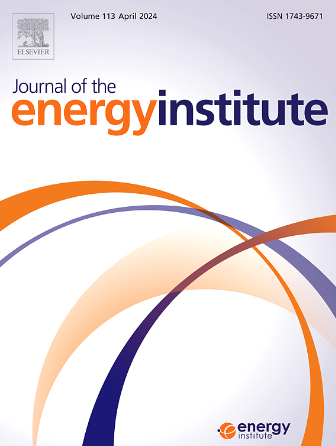加压 O2/H2O 条件下木炭燃烧的实验和模型研究
IF 5.6
2区 工程技术
Q2 ENERGY & FUELS
引用次数: 0
摘要
本文基于 C++ 程序,结合建立的 Langmuir-Hinshelwood(L-H)动力学模型和加压炭燃烧的实验数据,确定了加压燃烧和气化反应的解吸动力学参数,并完善了已建立的加压炭-O2/H2O 燃烧 L-H 动力学模型。在涉及加压木炭-O2 和木炭-H2O 的反应中,解吸活化能被确定为 250.8 kJ/mol,预指数为 5.42 × 1010 g/(m2 s)。在此基础上,本研究进行了模拟,研究了温度、压力和 H2O 浓度对加压炭-O2/H2O 燃烧中氧化吸附率(Rads,oxi)、解吸率(Rdes)、气化吸附率(Rads,gas)的影响,以及动力学和扩散过程的竞争影响。模拟结果表明,随着炭转化率达到峰值,Rdes 和 Rads,gas 逐渐增加,随后逐渐下降。相反,在整个木炭转化过程中,Rads,oxi 变化平稳。在 1673 K/1.0 MPa 条件下,炭-O2/H2O 反应速率主要受 Rads,oxi 和 Rads,gas 的制约,吸附反应是速率控制步骤。此外,研究还发现,压力升高会导致 Rads,oxi、Rdes 和 Rads,gas 的线性增加。在高温条件下,压力对它们的影响更加明显。不过,引入 H2O 可以减轻这种影响。温度和压力的升高促进了炭-氧气燃烧动力学对氧气扩散的竞争,导致炭的转化更容易受到氧气扩散速率的限制。加入 20% H2O 后,竞争效应减弱。在涉及木炭和 O2/H2O 的加压燃烧中,木炭转化率主要受制于 O2 扩散速率,几乎不受 H2O 扩散速率的影响。本文章由计算机程序翻译,如有差异,请以英文原文为准。
Experimental and modeling studies on char combustion under pressurized O2/H2O conditions
The desorption kinetic parameters for pressurized combustion and gasification reactions were determined based on a C++ program coupled with the Langmuir-Hinshelwood (L-H) kinetic model developed and experimental data from pressurized char combustion, and the established L-H kinetic model for pressurized char-O2/H2O combustion was refined in the current paper. The activation energy for desorption in reactions involving pressurized char-O2 and char-H2O was determined to be 250.8 kJ/mol, accompanied by a pre-exponential factor of 5.42 × 1010 g/(m2 s). Using this foundation, the current research conducted simulations to investigate the impacts of temperature, pressure, and H2O concentration on the oxidation adsorption rate (Rads,oxi), desorption rate (Rdes), gasification adsorption rate (Rads,gas), and the competitive influences of kinetics and diffusion processes within the pressurized char-O2/H2O combustion. The simulation results indicate a gradual increase in Rdes and Rads,gas with char conversion to reach a peak, followed by a gradual decline. Conversely, the Rads,oxi varies smoothly throughout the char conversion process. At 1673 K/1.0 MPa, the char-O2/H2O reaction rate is primarily constrained by Rads,oxi and Rads,gas, with the adsorption reaction serving as the rate-controlling step. Moreover, it was noted that a rise in pressure resulted in a linear increase in Rads,oxi, Rdes, and Rads,gas. At elevated temperatures, the impact of pressure on them becomes more noticeable. However, the introduction of H2O mitigates this effect. Elevated temperature and pressure facilitate the competition on the kinetics of char-O2 combustion for O2 diffusion, resulting in the conversion of char being more susceptible to O2 diffusion rate limitation. With the addition of 20 % H2O, the competition effect was weakened. In the case of pressurized combustion involving char and O2/H2O, the char conversion is primarily constrained by the O2 diffusion rate and is scarcely influenced by the H2O diffusion rate.
求助全文
通过发布文献求助,成功后即可免费获取论文全文。
去求助
来源期刊

Journal of The Energy Institute
工程技术-能源与燃料
CiteScore
10.60
自引率
5.30%
发文量
166
审稿时长
16 days
期刊介绍:
The Journal of the Energy Institute provides peer reviewed coverage of original high quality research on energy, engineering and technology.The coverage is broad and the main areas of interest include:
Combustion engineering and associated technologies; process heating; power generation; engines and propulsion; emissions and environmental pollution control; clean coal technologies; carbon abatement technologies
Emissions and environmental pollution control; safety and hazards;
Clean coal technologies; carbon abatement technologies, including carbon capture and storage, CCS;
Petroleum engineering and fuel quality, including storage and transport
Alternative energy sources; biomass utilisation and biomass conversion technologies; energy from waste, incineration and recycling
Energy conversion, energy recovery and energy efficiency; space heating, fuel cells, heat pumps and cooling systems
Energy storage
The journal''s coverage reflects changes in energy technology that result from the transition to more efficient energy production and end use together with reduced carbon emission.
 求助内容:
求助内容: 应助结果提醒方式:
应助结果提醒方式:


